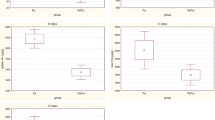Abstract
An experiment was performed to determine the effect of diethyl maleate (DEM), and in vivo depletor of glutathione, on the response of male and female rats to arsenic deprivation. A 2×2×2 factorially arranged experiment used groups of six weanling Sprague-Dawley rats. Dietary variables were arsenic at 0 or 0.5 μg/g and DEM at 0 or 0.25%; the third variable was gender. Animals were fed for 10 wk a casein-ground corn based diet that contained amounts of calcium, phosphorus, and magnesium similar to the AIN-76 diet. DEM supplementation increased blood arsenic in both male and female rats; female rats had the greatest amount of arsenic in whole blood. Although female rats in general had a lower concentration of glutathione in liver, those fed no supplemental DEM, regardless of their arsenic status, had the lowest amounts. Compared to males, female rats had a lower activity of liver glutathione S-transferase (GST). Arsenic deprivation decreased, and DEM supplementation increased liver GST activity in both male and female rats. Lung GST activity was also increased by DEM supplementation in male, but not female, rats. The most striking finding of the study was that compared to males, females had extremely elevated kidney calcium concentrations, and that the elevation was exacerbated by arsenic deprivation. DEM supplementation also exacerbated the accumulation of calcium in the kidney of the female rats. The response of the rat to both DEM and arsenic was, for many variables, dependent on gender. This gender dependence may be explained by the differences in methionine metabolism between male and female rats. Thus, arsenic deprivation apparently can manifest itself differently depending on gender.
Similar content being viewed by others
References
E. Uthus and R. Poellot,Mag. Trace Elem. 10, 339–347 (1991-92).
E. Uthus and R. Poellot,J. Trace Elem. Exp. Med. 5, 153–164 (1992).
E. O. Uthus,Environ. Geochem. Health 14, 55–58 (1992).
J. L. Plummer, B. R. Smith, H. Sies, and J. R. Bend,Methods in Enzymology, vol. 77, Jakoby, W. B., ed., Academic, New York, pp. 50–59 (1981).
E. Soon, N. Johnson, and B. C. F. Snider,J. Nutr. 114, 1853–1862 (1984).
J. De La Rosa and M. H. Stipanuk,Comp. Biochem. Physiol. B 81, 565–571 (1985).
F. H. Nielsen and B. Bailey,Lab. Anim. Sci. 29, 502–506 (1979).
F. H. Nielsen, D. R. Myron, S. H. Givand, and D. A. Ollerich,J. Nutr. 105, 1607–1619 (1975).
O. W. Griffith,Methods of Enzymatic Analysis, vol. VIII, 3rd ed., Bergmeyer, H. U., ed., VCH, Deerfield Beach, FL, pp. 521–529 (1985).
W. H. Habig and W. B. Jakoby,Methods in Enzymology, vol. 77, Jakoby, W. B., ed., Academic, New York, pp. 218–231 (1981).
W. H. Habig and W. B. Jakoby,Methods in Enzymology, vol. 77, Jakoby, W. B., ed., Academic, New York, pp. 398–405 (1981).
F. H. Nielsen, T. J. Zimmerman, T. R. Shuler, B. Brossart, and E. O. Uthus,Trace Elem. Exp. Med. 2, 21–29 (1989).
SAS InstituteSAS User's Guide: Statistics, ed. 5, SAS Institute, Cary (1985).
J. L. Barnhart and J. Combes,J. Pharmacol. Exp. Ther. 206, 614 (1978).
R. F. Burk and M. A. Correia,Res. Comm. Chem. Pathol. Pharmacol. 24, 205 (1979).
J. Alexander and J. Aaseth,Nutr. Res. Suppl. 1, S-515–S-519 (1985).
I. Anundi, J. Högberg, and M. Vahter,FEBS Lett. 145, 285–288 (1982).
S. Taketani, H. Kohno, T. Yoshinaga, and R. Tokunaga,Biochem. Int. 17, 665–672 (1988).
M. Hirose, M. Kagawa, K. Ogawa, A. Yamamoto, and N. Ito,Carcinogenesis 10, 2223–2226 (1989).
W. H. Habig, M. J. Pabst, and W. B. Jakoby,J. Biol. Chem. 249, 7130–7139 (1974).
O. W. Griffith,Methods in Enzymology, vol. 77, Jakoby, W. B., ed., Academic, New York, pp. 59–63 (1981).
T. O. Eloranta, V. Martikainen, and T. K. Smith,Proc. Soc. Exp. Biol. Med. 194, 364–371 (1989).
G.-P. Xue and A. M. Snoswell,Comp. Biochem. Physiol. B 80, 489–494 (1985).
A. J. Barak, H. C. Beckenhauer, and D. J. Tuma,Anal. Biochem. 127, 372–375 (1982).
S. H. Mudd and J. R. Poole,Metabolism 24, 721–735 (1975).
E. O. Uthus,Mag. Trace Elem. 9, 227–232 (1990).
E. O. Uthus,Proc. ND Acad. Sci. 47, 56 (1993).
H. Garcin, C. Suberville, and P. Higueret,Brit. J. Nutr. 61, 301–307 (1989).
J. P. Buchet and R. Lauwerys,Arch. Toxicol. 57, 125–129 (1985).
E. O. Uthus, R. Poellot, and F. H. Nielsen,6th International Trace Element Symposium 1989, M. Anke, W. Baumann, H. Bräunlich, Chr. Brückner, B. Groppel, and M. Grun, eds., Friedrich-Schiller-Universität, Jena, pp. 1013–1017 (1989).
W. E. Cornatzer, E. O. Uthus, J. A., Haning, and F. H. Nielsen,Nutr. Rep. Internat. 27, 821–829 (1983).
M. Vahter and E. Marafante,Spec. Publ.-R Soc. Chem. 66, 105–119 (1988).
C. Adams, J. Ritskes-Hoitinga, A. G. Lemmens, and A. C. Beynen,Nutr. Rep. Internat. 40, 923–929 (1989).
B. G. Shah, K. D. Trick, and B. Belonje,Nutr. Res. 6, 559–570 (1986).
B. G. Shah, and B. Belonje,Nutr. Res. 11, 385–390 (1991).
P. G. Reeves, K. L. Rossow, and J. Lindlauf,J. Nutr.,123, 1923–1931 (1993).
Author information
Authors and Affiliations
Rights and permissions
About this article
Cite this article
Uthus, E.O. Diethyl maleate, an in vivo chemical depletor of glutathione, affects the response of male and female rats to arsenic deprivation. Biol Trace Elem Res 46, 247–259 (1994). https://doi.org/10.1007/BF02789300
Received:
Accepted:
Issue Date:
DOI: https://doi.org/10.1007/BF02789300




